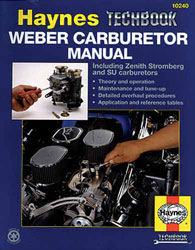Tuning and Troubleshooting Weber Carbs
Order Weber Carburetors, Parts, and Jets
Read the Pegasus Tech Page: Identifying Weber Carburetor Models
| We get several calls every day from people asking us to diagnose and tune their Weber carburetors for them. This can be very difficult over the phone, partially because we're not there with you and your car -- we can't go for a test drive, hear it run, see the exhaust, read the plugs, or put it on a dyno. It's a bit like asking the doctor for a diagnosis over the phone. Also, there are very few jetting charts in existence (and we can guarantee with absolute certainty that your combination isn't in ANY of them). We can't just look up the answer! Tuning carburetors takes time, patience, and a lot of trial and error. People who specialize in carb tuning keep a lot of different jet sizes on hand so they can experiment until they get it right. Really experienced tuners manage to get it right on the first try about half the time. If you find someone who gets it right the first time, every time... take your car to him, be nice to him, and PAY HIM! |
Read the Pegasus Tech Page: Identifying Weber Carburetor Models
Order Weber Carburetors, Parts, and Jets
Order Weber Carburetors by Pat Braden (Part No. 5326)
How to Start
Our first recommendation is always to buy one of the excellent books on Weber carbs and read it cover-to-cover. (The Pat Braden book above has 5-star reviews from our customers.) Yes, there is some information in there you might not need (now), but it explains core concepts and shows just how these complex little fuel mixers work -- which will put you miles ahead when the carb needs attention again.
If you have sidedraft DCOE carbs, track down a copy of Des Hammill's in-depth and sadly out-of-print How to Build & Power Tune Weber & Dellorto Carburettors (ISBN 978‑190370675‑6 / 781903‑706756). Trust us, it is worth every penny for DCOE owners. If you read and absorb everything in that book, you can make your money back by opening your own Weber DCOE tuning shop.
What's next
Our second recommendation is NOT to ask the internet. Seriously, just don't. "But this guy on one of the message boards said..." No.
On the other hand, IF someone was kind enough to post a jetting chart based on real-world testing of your exact combination, that's great! It means that person has much more experience with your combination than we do, and his recommendation will get you a lot closer than we possibly could. Which also means you're done, you have the answer, you don't need a second opinion.
And then?
Our third recommendation is to CHECK AND ADJUST THE FLOAT LEVEL. In racing, the fast guys check the float level at least once every weekend. Usually they do it when they arrive at the track, because towing the car to the track can knock the float out of adjustment. Meanwhile, you've been driving your street toy over potholes and speed bumps (or even off-road), which hammers the float even worse. And if you just bought your carb, how gently do you think the shipper handled it? CHECK AND ADJUST THE FLOAT LEVEL.
This is particularly critical on downdraft carbs (DGV / DGES), where just a 4mm (5/32") drop in float height can take you from plug-fouling rich to plug-melting lean. (A book on Weber carbs would come in really handy right now.)
I just bought a used carb. What size jets should be in this thing?
There is NO universal answer to that question. If there were, Weber wouldn't make different jet sizes! Again, we can try to extrapolate (yeah) an answer from sort-of-similar combinations in an outdated European OEM jetting list (found in the now out-of-print Haynes Weber Carburetor Shop Manual, formerly Part No. 5313), but that will only be a suggested starting point. You will likely find that your combination needs something different.
At this point we also need to ask: What else might be wrong with it? Did the seller ever have it running? Did he try some "trick" he read about online? If so, you might have paid for a carb that somebody else ruined. At best, you have no idea what is inside. You need to take it apart and examine it. (A book on Weber carbs would come in really handy right now.)
My car doesn't run right, I need to order different jets.
Not so fast! Let's back up a second and ask: Did this combination ever run right? If so, what changed to make it run poorly? Jets don't wear out or change sizes with age. If your car ran well last week and doesn't run well this week, something else changed. It could be something in the carburetor (*cough* FLOAT LEVEL! *cough*), or it might not. Whatever it is, you need to change it back (i.e., fix it).
The only time that you should change jet sizes when nothing else on the car has changed is if you move to a different altitude. In that case, you ONLY need to change the main jets. Weber recommends going one step leaner than at sea level for 5000-6500 feet and 2 steps leaner for 6600-9800 feet elevation. (For example, if you run 160 main jets in Illinois, you would run 155 mains in Denver. You wouldn't need to break out the 150 mains until you get to Aspen.)
If the car never ran properly since the carb was installed, the next step is to open the carb and find out what jet sizes are in it. THIS IS CRITICAL. If you start by ordering jets, chances are really good that you'll order the same sizes that you already have. We'll happily take back unused jets for a refund, but the only ones making money at that point are the shipping companies. Let's take a moment to find out our baseline first! A half an hour of work in the garage sure beats waiting ANOTHER week for the second shipment of jets, doesn't it?
Once you know what jet sizes are in it, then we can discuss which direction you need to move. Do you need to change main jets, idle jets, air jets, or all three? (A book on Weber carbs would come in really handy right now.) The main jets affect the mixture at all RPM ranges and throttle openings. The idle jets affect the mixture at and just above idle speed, the air jets affect the mixture at high RPM, and the emulsion tubes affect where and how the air jets come in to play. And then there are the adjustments for idle mixture and idle speed. (A book on Weber carbs would come in really handy right now!)


